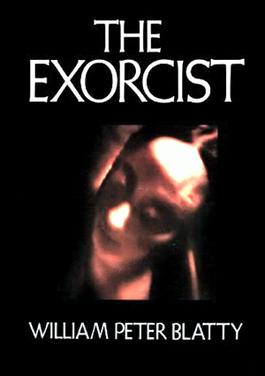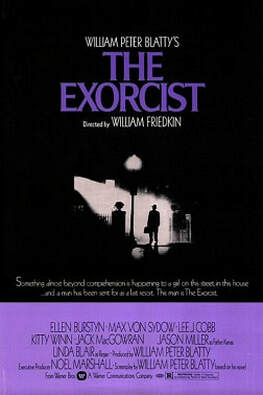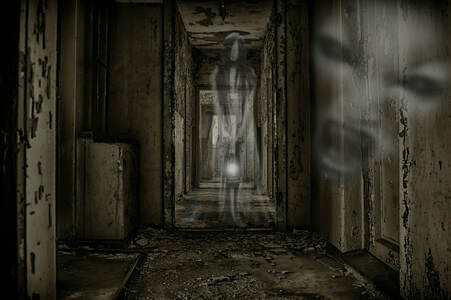 Book Cover of The Exorcist Book Cover of The Exorcist A long time ago, back when I was a young teenager, my mother bought the book The Exorcist by William Peter Blatty. This book is about the possession of a girl by a demon and her subsequent exorcism. My mother placed it in our book room. However, she thought that it contained things that were not appropriate for my age. So she called me over and explained that she had bought this book, but she did not want me to read it — Mom, really? Needless to say that as soon as I had a chance, I made a bee line for the book room and read the book: bad idea. The descriptions and the language in the book terrified me. I could not get the images and words out of my mind, and for about a week I did not sleep well. As soon as I turned off the light every sound and shadow in the room acquired a sinister nature, and I was be consumed by fear. At times I thought I saw things moving about my room. At times I thought I heard voices. It was really creepy, and the worst thing is that I could not tell my mother because she would figure out I had read the book! However, by the time I got to see the movie based on the book, I had gotten my act together enough to see the film without losing my composure.  Poster of the Movie The Exorcist Poster of the Movie The Exorcist Fast forward 20 years or so. I studied biology in college and later obtained a Ph.D. in Nutrition with a major in Biochemistry. I learned the ways of science and how matter and energy in this world operate based on specific physical, chemical, and biological principles. I published a weekly newspaper column entitled “The Scientific Truth” that dealt critically with pseudoscience and the paranormal. I still remembered my Exorcist-induced week of fright, but I interpreted what had happened to me under a whole new light. What happened to me was due to the fact that human perception is not a passive event. We do not merely take input from the environment to directly construct our perception of the world around us, but rather we are constantly interpreting this input based on a set of parameters that the brain applies to make sense of reality, and these parameters can be changed by experience. That day so many years ago, I was exposed to very strong stimuli that reshaped the perception of reality by my brain. The noises and shadows in my bedroom at nighttime had not changed from the way they had always been, but my brain reinterpreted them in light of the new information obtained from reading the book and made me fear them. Fear is often a useful emotion that can keep us from harm, but when fear is too intense or not based realistic premises, it can have paralyzing and unhealthy effects. I reasoned that my fear that night was a result of ignorance. Despite the claim that Blatty’s book was based on a real exorcism, not a single case of demonic possession has ever been conclusively demonstrated to be anything but mental illness. In the exorcisms that have taken place, objects don’t fly, lights don’t flicker, bodies don’t levitate, etc. The occurrences taking place in these events are within the realm of what’s possible when people experience mind-altering diseases. My fear that night was unwarranted. I felt a bit silly for having experienced it at all, and rolled my eyes at the gullibility of my former younger self.  Ghost Stories Ghost Stories So it happened that I found myself carrying out research that involved periodic trips to a faraway town by the sea, where I worked at a small research station. In one of these research trips, I was the only scientist working at the station. After I had been working for most of the day, there was a failure in the electric grid and the lights went out towards the late afternoon. Since my workroom didn’t have any windows, and I just had a rudimentary flashlight, I decided to call it a day. I had a quick dinner and headed into town right before dusk. There I came upon some of the local fishermen who had gathered around an improvised log fire. A couple of them worked with the research station, and I sat with them. The fishermen shared some of the local stories of the town’s past, and then as it got darker, they started telling ghost stories! For the next two hours next to the flickering light of the fire and under a sky faintly lit by a crescent moon, I heard these adults talk about things they had seen or heard during their lives. The lore included screams and moans of unknown origin coming from the mountains adjacent to the town, strange vaporous figures floating around at night, things hovering over the sea waters or lurking just beneath them, open graves with missing corpses at the local cemetery, the doom that had befallen some people cursed by an alleged local witch, etc. I alternated between being amazed and amused. I didn’t know to what extent these people were exaggerating their stories, but most of them seemed very convinced that they were true. I knew that groups of skeptics had been systematically investigating one claim after another of ghosts, witches, paranormal occurrences and whatnot for decades finding nothing that could not be explained by science. However, I did not want to be disrespectful. These fishermen were bonding and apparently having a good time, so I kept my mouth shut. After the group dissolved, I went back to the research station. It was quite dark and the silver glow of the moon gave the surrounding landscape a surreal pale phosphorescent tinge. Inside the research station it was pitch black and the faint light of my flashlight barely helped me make my way along the corridor that led to my bedroom. The shadows created by my flashlight seemed to move in strange ways, and I became aware of noises that I didn’t remember hearing before. Was there something lurking in the darkness beyond the glow of my flashlight? Was it moving towards me? The same sensations I had experienced 20 years ago came back in full force. This time, I was older. I knew better. I was not ignorant. I was not gullible, and yet, I was caught again in the grip of fear. Inside my brain an ancient program had been activated. A program derived from our animal ancestors, created by the forces of evolution, and amplified by superstition and ignorance. A program that for thousands of years made us fear what lay beyond the cave entrance or the perimeter of the campfire, even if there was nothing there. And I could not shut it down!
Thankfully an emotion stronger than fear came to my rescue: anger. I became extremely angry because, although I understood exactly what was happening to me, I was not able to control it. As I made my way along the dark corridor to my bedroom, I clenched my fist, waved it at the darkness, and screamed, “I’m a scientist”! This sounds stupid today, but that day it worked. I was able to counteract my fear with sheer outrage at how silly I felt at being manipulated by my own brain. After a couple of hours of more fist clenching, I was able to force myself to sleep. Next day the electricity returned, and that night I fell asleep uneventfully. What I understood after this experience, is that mere knowledge and/or conviction that something does not exist and can’t harm us does not immunize us against fearing it. We have all grown up within a culture that through oral stories, movies, books, and other means has conditioned our brains to accept at a very primal level that things like demonic possession, ghosts, and other fictitious entities or occurrences exist, can harm us, and should be feared. This conditioning can at times manipulate us like puppets and make us feel things that we are not justified in feeling from a rational point of view. But at least now I understand this: I am a scientist. The cover of the book The Exorcist and the poster of the movie are copyrighted and used here under the legal doctrine of Fair Use. The ghost picture by Alexas_Fotos is from Pixabay and is licensed for public use.
0 Comments
 In this post we are going to go over the several razors available for us to use. These razors, while commonly used by philosophers and scientists, in fact are often used by regular people, sometimes without even knowing that they are using them! However, these razors have nothing to do with the removal of bodily hair. They are called razors because they allow us to deal with the complexity of the world around us by reducing (cutting) the amount of possible explanations to various phenomena. We use them to simplify our thought processes and focus on meaningful explanations without getting lost in a bog of deceiving alternatives. We will examine several of these razors and see how they can be used to deal with the amount of bilge that is often found among claims of conspiracy theories, the pseudosciences, and the paranormal. 1) Occam’s Razor. This is the most well-known of all razors. It was developed by the English philosopher William of Ockham back in the fourteenth century. This razor posits that when faced with choosing between two competing alternatives that explain a phenomenon, we should choose the simplest one. In other words, we should not make things needlessly complicated. Many conspiracy theories such as those which claim that 9/11 was a US government-supported operation or that the US never landed on the moon run afoul of this razor. The sheer number of moving parts that would have to operate just right under a mantle of secrecy to bring about the events alleged in these conspiracies is just too complicated. The simpler explanation is that there was no conspiracy.
2) Hitchens's Razor. The late author, critic, and journalist Christopher Hitchens promulgated the dictum which states that what can be asserted without evidence, can be dismissed without evidence. The implication of this razor is that the burden of proof of a claim is with the claimant. You often hear many proponents of the occurrence of paranormal events declare that these phenomena have not been disproven. By this razor’s criteria, this argument is irrelevant. If you want people to accept a claim, YOU have to prove it is true, and you had better do a very damn good job at it to be taken seriously. 3) Sagan’s Standard. The late astronomer Carl Sagan popularized this aphorism which postulates that extraordinary claims require extraordinary proof. This standard recognizes that not all claims are created equal. Fantastical claims which run counter to scientific laws or mountains of evidence should only be accepted upon the production of truly remarkable evidence. By the metrics of this razor, claims for psychic phenomena, faith healers, and other such things fall short of the level of proof required to accept them. 4) Alder’s Razor. The Australian mathematician Mike Alder published an essay describing this razor, although at the time he called it “Newton’s Flaming Laser Sword” (which is a cooler name). The brutal postulate of this razor (or sword) states that what cannot be settled by experiment or observation is not worth debating. If you have ever had an exchange with a flat Earth proponent and regretted afterwards having lost one hour of your life, you have experienced in the flesh what Alder was talking about. 5) Popper’s Falsifiability Principle. The great philosopher of science Karl Popper coined this famous principle which states that for something to be considered scientific it must be falsifiable. What this means is that there must be a way of proving that a claim is false if it indeed is false, otherwise said claim is not scientific. And if a claim is not scientific, its truthfulness will never be settled by observation or experiment (see Alder’s Razor above). A classical feature of the thinking of those making fantastical claims is that they always move the goalposts. No possible observation or experimental result can prove them wrong. Therefore they can’t be right. On the other hand, science can be right because it can be wrong. 6) Hanlon’s Razor. This particular razor of uncertain origin deals with the motivations behind those who propose fantastical claims. It states that one should never attribute to malice that which is adequately explained by stupidity. While it is true that within the ranks of those who believe in and peddle fantastical claims there are many liars and cheats, this razor reminds us that there are also scores of honest individuals who are just guilty of self-delusion or who have been bamboozled into accepting and defending these claims. In a recent post I reminded my readers about the dangers of keeping one’s mind too open (i.e. it can easily be filled with trash). Well, I guarantee that if you put these razors between you and the vast vortices of irrationality and trickery that swirl about us, your mind will be spared! The image is by Horst.Burkhardt is used here under an Attribution-Share Alike 3.0 Unported license.  In the popular print and social media I often spot articles about the benefits of keeping an open mind. I also read how it is very important for scientists to keep an open mind. What these articles never discuss is the danger of keeping an open mind. This danger is that you will lose your power to discriminate between sound and fallacious ideas. For example, in 1917 two girls in the village of Cottingley in England took pictures of what appeared to be fairies flying and dancing around them. Among the many people fooled into believing the pictures were real was no other than the creator of Sherlock Holmes, Arthur Conan Doyle. More recent examples are the comedian and trickster extraordinaire, Andy Kaufman, who in 1984 visited a psychic surgeon to treat his cancer (he died), or the actor Dan Aykroyd, of Ghostbusters fame, who believes among other things in mediums and psychics and paranormal phenomena. This is not to say that only non-scientists fall victim to keeping their mind too open. There are many scientists of renown who have ended up accepting ideas or theories that were dubious at best, or patently false at worst. The co-discoverer (along with Darwin) of the theory of evolution, Alfred Russel Wallace, was a believer in psychic phenomena and spiritualism; and led an anti-vaccination campaign. Isaac Newton, the genius behind the laws of gravitation, believed the Bible had a code that predicted the future which he tried to decipher for many years. The Nobel Prize winning physicist William Shockley invented the transistor and revolutionized society, but he also defended theories that proposed the intellectual inferiority of some races. Linus Pauling, a Nobel Prize winning chemist, advocated the use of vitamin C to cure cancer despite the evidence against it. Lynn Margulis, winner of the National Medal of Science, revolutionized the theory of evolution with the concept of endosymbiosis which postulates that mitochondria and chloroplasts originated from bacteria. She also championed several fringe theories, and joined the 911 conspiracy movement that claims that it was a false flag operation to justify the wars in Iraq and Afghanistan. The irony is that Margulis had been married to that great skeptic, the late astronomer Carl Sagan. Kari Mullis won the Nobel Prize for the polymerase chain reaction (PCR), a technique which ushered a revolution in areas ranging from medicine to forensics. Not only is he an AIDs denialist along with Peter Duesberg (see below), but he denies climate change and accepts astrology. It is important to understand that the dangers of keeping an open mind have consequences that go beyond mere public ridicule. When people in positions of eminence are swayed by erroneous ideas, this can have a negative effect on society. Consider the brilliant scientist Peter Duesberg. He performed pioneering work in how viruses can cause cancer, but he was convinced that the HIV virus did not cause AIDS. His advocacy for this idea influenced the South African president Thabo Mbeki who delayed the introduction of anti-AIDS drugs into South Africa leading to hundreds of thousands of preventable deaths. In scientific research keeping an open mind is a quandary that involves navigating between making two types of errors. The first is that a mind that is too closed will reject things as false when they are really true. The second is that a mind that is too open will accept things as true when they are really false. The intuitive way to deal with this quandary is to try to strike a balance between the extremes. However, this is not how most scientists approach the issue. Science tends to be conservative in that it gives more importance to what has already been proven. Scientists view with skepticism those trying to subvert established science. The bar is set very high for the acceptance of new ideas. Most scientists view rejecting something as false when it’s really true as a lesser evil compared to accepting something as true when it’s really false. In the end, however, it will be the evidence and its reproducibility which will make the difference.  On the other hand, in the pseudosciences and the paranormal, the advice of keeping an open mind is often dispensed by those advocating for the existence of psychic phenomena, extrasensory perception, demonic possession, ghosts, telepathy, alien abductions, clairvoyance, mediums, astrology, witches, reincarnation, telekinesis, telepathy, faith healing, and many other fantastical claims. I want to suggest that, as a first step, the safest frame of mind when considering these claims is to vanish the open mind, and assume that the persons making the extraordinary claims are at best deluding themselves, and at worst liars and cheats. This suggestion may scandalize many people, and may come across as an incredibly narrow-minded and unfair approach to investigating anything. How can you find if something is true if you are prejudiced against the possibility that it’s true? The answer is that in this fringe you are dealing with events that, in principle, run counter to well-established scientific laws, or against mountains of evidence. In other words, you are dealing with the impossible. By definition the impossible is not possible and should be treated as such. When considering these claims, if you keep an open mind, you have often lost the battle. This painful lesson has been learned by many scientists that investigated fantastical claims with an open mind just to be fooled by tricks so basic that they would make seasoned magicians roll their eyes (incidentally, this is also why it is always advisable to have a magician as a consultant when investigating these claims). Scientists are the worst possible individuals to rely upon when attempting the investigation of fantastical claims. Scientists are trained to deal with nature, and nature operates based on a fixed set of rules. Natural phenomena don’t change to prevent you from studying them. Nature doesn’t cheat, lie, or delude itself. An open mind is justified only when studying natural phenomena. An open mind in any other setting is a liability. Once you have ruled out trickery and self-delusion and stablished that what you are studying is indeed a natural phenomenon, then you can consider opening your mind to the possibility that it is true. Individuals ranging from common folk to Nobel Prize winners should always remember that if you keep your mind too open, people will dump a lot of trash in it. The image is a scan of the original Cottingley Fairy pictures and is in the public domain in the United States. The open mind image by ElisaRiva is used here under a CC0 1.0 Universal (CC0 1.0) license. |
Details
Categories
All
Archives
June 2024
|
 RSS Feed
RSS Feed